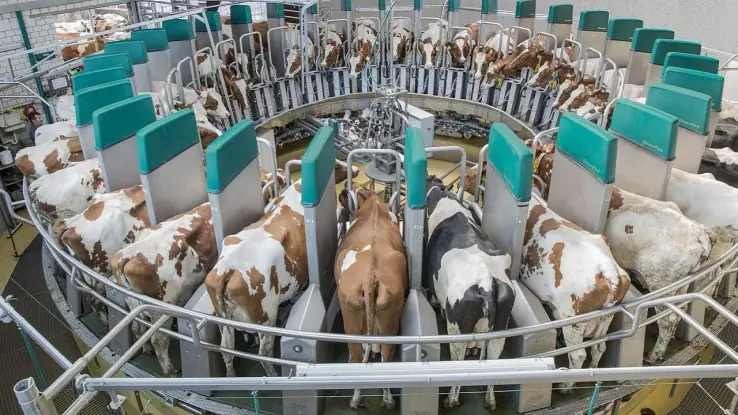The Hidden Cruelty: The Dark Side of Milk Production
The image of a happy cow grazing in a lush green pasture is often used to promote the idyllic image of dairy farming. However, the reality behind milk production is far from idyllic, with countless animals subjected to inhumane practices.

Forced Motherhood and Heartbreak:
Dairy cows are bred to produce as much milk as possible. To ensure a constant supply, they are repeatedly artificially inseminated, often without proper anesthesia. This invasive procedure can be painful and stressful for the cows.
Immediately after giving birth, calves are typically separated from their mothers within hours. This unnatural separation causes immense distress for both the cow and her calf, as they have a strong maternal bond. The calves are often raised in isolation and fed a milk replacer, a synthetic formula that lacks the nutrients and antibodies found in colostrum, the first milk produced by the mother.
Life in a Cage:
Dairy cows are often kept in confined spaces, such as stalls or tie-ups, that severely restrict their movement. These conditions can lead to a range of health problems, including lameness, respiratory issues, and digestive disorders.
In addition to physical discomfort, confinement can also cause psychological distress. Cows are social animals that crave companionship and the opportunity to graze freely. When deprived of these natural behaviors, they may exhibit signs of frustration and anxiety.
- Stereotypies: These are repetitive behaviors that serve no obvious purpose, such as pacing, head-shaking, or bar chewing.
- Aggression: Cows may become aggressive towards other animals or humans, especially during milking or handling.
- Reduced Milk Production: Chronic stress can lead to a decline in milk production.
- Health Problems: Stress can weaken the immune system, making cows more susceptible to diseases and infections.
- Abnormal Behaviors: Cows may exhibit abnormal behaviors, such as excessive vocalization or self-mutilation.
Hormones and Infections:
To maximize milk production, dairy cows are often treated with hormones, such as growth hormone and bovine somatotropin (BST). These hormones can increase the risk of health problems, including mastitis, a painful and infectious disease that affects the udder.
Mastitis is a common problem in dairy herds, and it is often treated with antibiotics. The overuse of antibiotics can contribute to the development of antibiotic-resistant bacteria, which poses a serious threat to human health. To understand more about bacteria resistance through misuse of antibiotics, read this article.
The Cycle of a Dairy Cow's Life:
A dairy cow typically gets pregnant every year through artificial insemination. Before she is due to give birth, she enters a dry period of about 60 days, during which she is not milked (although she could be lactating from childbearing from the previous birth). This allows her body to recover and prepare for the next pregnancy. Following the dry period, the cow is artificially inseminated. The gestation period for a cow is approximately 9 months, after which she will give birth to a calf and begin producing milk again. This cycle continues year after year to ensure a constant supply of milk. A dairy cow in a factory farm will typically produce milk for around 3-5 years. After this period, her milk production may decline significantly due to factors such as age-related health issues or reduced fertility.
Once a cow's milk production becomes economically unsustainable, she is often sent to slaughter. This practice is often referred to as "culled" in the dairy industry.
The Ethical Question:
The practices used in milk production raise serious ethical concerns. The suffering endured by dairy cows is undeniable, and the environmental impact of intensive dairy farming is significant.
Consuming dairy products supports an industry that relies on the exploitation of animals. By choosing plant-based alternatives, individuals can make a powerful statement against cruelty and help to create a more compassionate and sustainable world.
A Choice for Compassion:
The hidden cruelty behind milk production is a stark contrast to the idealized image often portrayed. By understanding the inhumane practices involved, consumers can make informed choices about their diet and support a more ethical and sustainable food system
